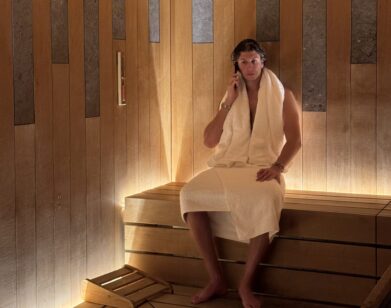Arnhem Mode BiennialHas a Muse Called Amber
In the Dutch countryside on the Rhine River lies the quiet but pulsing city of Arnhem, host to the mounting success that is the Arnhem Mode Biennale (on view through July 3), the biannual fashion exhibition founded in 2005. International heavyweights have imparted their aesthetic visions over the years—from Lanvin to Rick Owens, Calvin Klein to the Maison Martin Margiela—and the 2011 edition is no different, with over 100 participating designers, labels, artists and photographers creating site-specific installations (Prada flew in a segment of their spring/summer 2011 steel catwalk, and Rodarte set their silhouettes under black light to the tune of Elvis Presley’s “Blue Moon”).
The Biennale’s Brooklyn-based curator JOFF (né Joffrey Moolhuizen) is the fashion editor of Dutch fashion mag BLEND, and stepped into his role as creative director of the event in 2009. For one month, the biennial takes over a disused salt factory and spills across the city into satellite installations.
DANIEL THAWLEY: I heard that in preparation for this biennial, you wrote love letters to an imaginary muse named Amber. True?
JOFF: I called her Amber, to eliminate the perversion of the word “fashion.” I wanted to personify fashion—to show that it is for everyone. “Amber” is short for Arnhem Mode Biennale—and the “er” signifies one who is an active player.
THAWLEY: Can you explain the concept of the main exhibition, “CULTURES?”
JOFF: I asked designers to imagine a pitch-black room with a glowing light bulb. The first ring of light would be the collection, while the surrounding rings illuminate other aspects of their vision. We created a setting where the designer could present a total vision, beyond the garment. In some cases, designers didn’t really have time to create something for the exhibition, so in the case of Jil Sander, I proposed the idea of magnifying “Fresnel” lenses to their designer Raf Simons—lenses that literally zoom in on the pieces. He loved the idea, so we went with it.
THAWLEY: There is a strong presence of American designers in the Biennale, like threeASFOUR, Ohne Titel, Rodarte, and Thom Browne. Is that a result of the time you’ve spent living in New York?
JOFF: I don’t have a specific preference for the American designers; perhaps it has just evolved that way unconsciously, though I feel there is a lot of new talent there. To be honest, I didn’t really consider nationalities as much—it seems irrelevant these days.
THAWLEY: How did you define the mix of established and emerging talent in the exhibition?
JOFF: I don’t believe in any type of hierarchy. As much as the major brands play a very important role (which I very much respect) I also believe that the younger designers deserve an equal place, as they bring a lot of new ideas and innovation to the table. I think it is interesting to see the contrast of Prada installed next to, say, Wendy & Jim from Austria.
THAWLEY: One of Arnhem’s claims to fame is the success of the dynamic duo Viktor & Rolf, the Dutch duo whose alma mater is the Arnhem ArtEZ Academy. How do you feel their influence on young designers today?
JOFF: Viktor & Rolf have definitely put Arnhem on the map with their success, yet there are many other designers who have their roots in Arnhem too. For example, Lanvin’s menswear designer Lukas Ossendrijver, and many newcomers like Iris Van Herpen, Sander Lak and Maarten Van Der Horst. The Netherlands has a rich cultural landscape; there is a lot space for experimentation and innovation.
THAWLEY: How long have you been involved with the Biennale? Do you feel it will have a lasting impact on the city?
JOFF: Since 2005 I worked closely as co-curator alongside the former artistic director Piet Paris, and I became artistic director, when he left in 2009. Each edition the event has had a large impact on the city, growing every time. Many shops and organizations become a part of the project through a citywide shopping route, pop-up stores and exhibitions. The entire city transforms.







